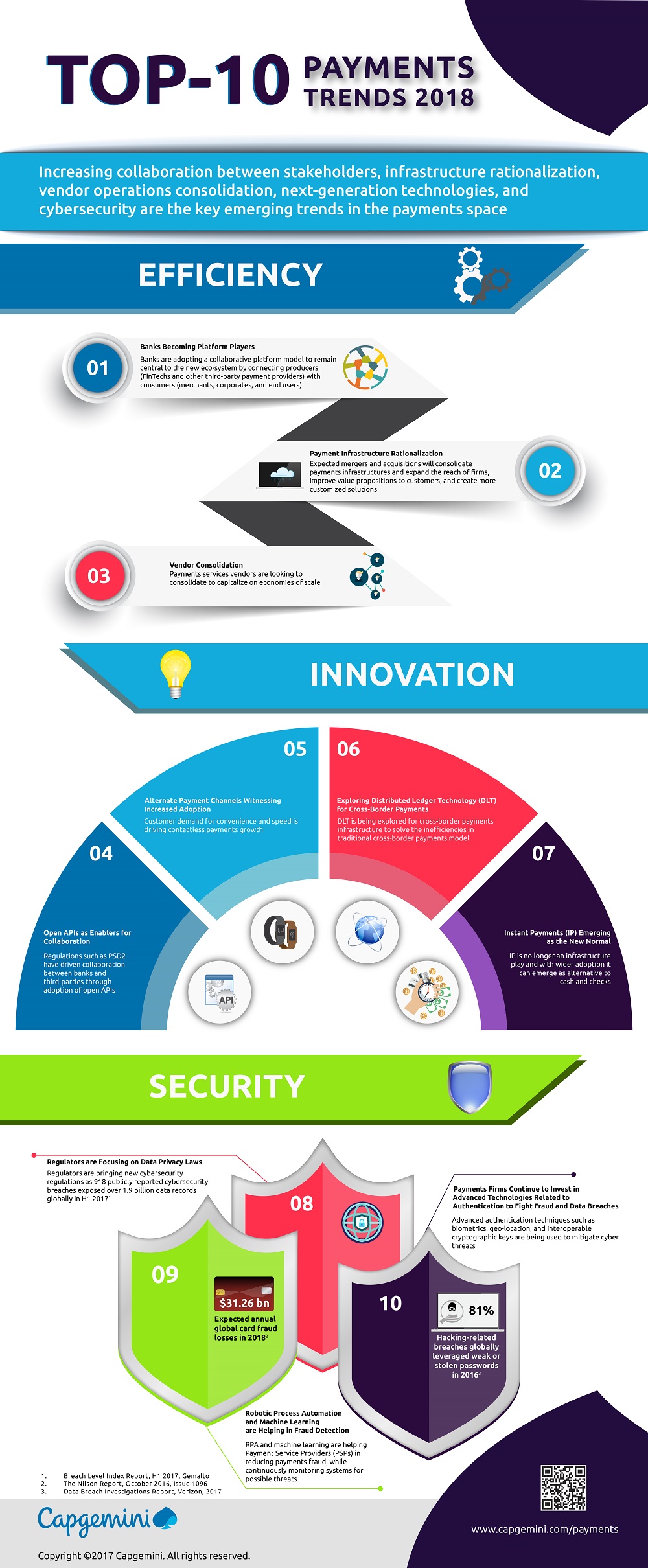Its that time of the year where all the top firms report and predict their hot payment trends for the new year. One of the earliest firms to get the payment trends ball rolling was Capgemini. In December 2017 Capgemini released their Top 10 Trends in Payments 2018, which is a widely recognised and quoted payment report.
I would strongly recommend that you read the 2018 Payment Trends report for full details, below is a quick summary. The report divides the payment trends into 4 key areas:
- Collaborative Payments Ecosystems
- Next Generation Payments
- Payments Player Rationalisation
- Cyber-security
Although the Top 10 Payments Trends 2018 Infographic (below) divides the trends into 3 main areas:
- Efficiency
- Innovation
- Security
1: Banks become Payment Platforms that facilitate Collaboration in a bid to remain Relevant
In short competition from Fintech companies, regulation and the very real threat of losing market share will force banks to adjust their operating models. Moving to a platform based model will allow banks to retain their relevance in an increasingly innovative and fast changing financial landscape.
2. Mergers and Acquisitions will result in Payment Infrastructure Rationalisation
Payment infrastructures are transforming and becoming faster and open to different players and products. As the movers and shakers in the payments space look to create an ecosystem they will naturally look for opportunities to merge and collaborate such that they can extend reach and services.
3. Open Banking will result in players in the Payments space to Consolidate
Opening Banking will increase Competition which will in turn reduce margins and drive payments companies (incumbents, banks and innovative third party payment service providers) to consolidate and form larger companies.
4. Open APIs will become HOT and drive Collaboration
In Europe PSD2 (Payments Services Directive) will catapult APIs (Application Programming Interfaces) to a whole new level. In short PSD2 will:
- Allow AISPs (Account Information Service Providers) to access (with explicit permission, of course) customer account information (and potentially offer new products/services) using APIs
- Allow TPP (Third Party Payment Service Providers) to make payments using APIs
- Drive innovation in financial services using APIs
- Increase competition in financial services using APIs
- Facilitate collaboration in financial services using APIs
5. Alternative Payment Channels – Mobile, Contactless and Augmented Not
Personally i don’t think mobile and contactless payments can be considered “alternative” anymore. The point here is that these various non-cash channels start to gain widespread acceptance. Customer demand for fast, simple and seamless payments together with the recent explosion in contactless devices, mobile banking, various payment apps and the anticipated growth of Internet of Things (IoT) connected devices (15 billion by 2021 – sorry, I’m bored of that stat too!) are all contributing to this trend.
6. Will Distributed Ledger Technology solve the Cross Border Payments Conundrum?
The opportunity to revolutionise cross border payments by removing multiple, slow, inefficient and costly correspondent banks is the holy grail of payments. Banks and Fintech companies are exploring this opportunity, after the significant hype of recent years will something noteworthy finally happen in 2018…?
7. Instant Payments become the “new normal”, for Corporates too!
Interesting. Here Capgemini talk about the implementation and development of various instant payment systems across the globe. Clearly in the retail space customers want instant payments. Here Capgemini go a step further and suggest that corporates also have an appetite for instant payments – enabling improved liquidity management.
8. Increasing Cyber-attacks put the spotlight on Data-Privacy Laws
Many of the recent high-profile cyber-attacks could have been avoided, and this negligence is driving regulators to focus on data-privacy. As the bad-actors become ever more sophisticated and the attacks increase in frequency and impact, there is widespread concern about the degradation of trust in the financial system. Regulations such as New York’s Cybersecurity Regulation and the EU GDPR (General Data Protection Regulation) will further put the spotlight on data-privacy law regulations in 2018.
9. Robotic Process Automation (RPA) and Machine Learning help to combat Fraud
Robotic Process Automation and Machine Learning enable organisation to review and identify unusual payment patterns, mine customer historical purchasing patterns and based on the analysis assess whether a fraudulent payment has been made. This analysis can happen in close to real time and with a greater degree of accuracy compared to a human. As the fraud threat increases, digitisation increases and the cyberattacks become more sophisticated RPA and Machine Learning also become an important tool in the detection effort.
10. Increased Investment in Authentication Technologies to Combat Fraud and Cyber-Attacks
As the payments industry becomes more and more digitised (see above), so the cyber-threat increases. Open banking, collaboration, access to account information, 15 billion connected devices by 2021 combined with the trend of increased losses by banks, corporates and customers due to various cyber-attacks is driving investment in authentication technologies such as biometrics, digital identity, secure-element, geo-location and inter-operable crytopgraphic keys.
Interesting stuff, eh?
